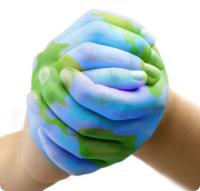Telecoupling
Telecoupling and the global trade of soybeans
International food trade and globalized agriculture production have significantly increased over the past several decades resulting in telecouplings where domestic food consumption relies on distant production.

Telecoupling is a new integrated way to study human and natural interactions over distances. Travel, technology and globalization means impacts are felt all over the world. Telecoupling combines “tele” – which means over distance – with coupling – human and natural systems which always act together.
The idea was introduced by Jianguo "Jack" Liu and colleagues at an American Association for the Advancement of Science meeting in 2011. It since then has caught on and being used by scientists all over the world to take a holistic view of some of the planet’s greatest challenges – climate change, biodiversity loss, conservation, sand consumption.
As population growth increases global caloric demand and increased affluence drives changes in consumption patterns, we can expect connections via food trade to strengthen and increase. These phenomena have been implicated as the main drivers of increased crop production and trade as well as the associated environmental and socioeconomic impacts. International soybean trade is representative of how distant places are connected through these complex trade networks. The volume of soybeans traded globally has increased over four times the amount traded in 2001, when China joined the World Trade Organization. China, a historic soybean producer, is the main driver of increased demand importing over 60 percent of the global soybean supply, most of which (~80%) is exported from Brazil and the United States.
And... a deeper dive
The telecoupling framework is an ideal tool for understanding the complex interactions within global soybean trade, offering a novel integration of natural and social systems across distances that historically would have been studied in their respective disciplines.
The telecoupling framework consists of five interrelated components: systems, flows, agents, causes, and effects. Systems are coupled human and natural systems that exchange information, material, and energy with other systems, which may be located relatively close or far away. Systems can be further classified as sending (origins, exporting country), receiving (destinations, importing countries), and spillover systems.
- Global soybean trade is a perfect example of this, where the importing country is the receiving system and the exporting country is the sending system.
- Movement of soybeans represents the flows, which could also be forms of information, materials, or energy responsible for connecting the two systems.
- Spillover systems are a byproduct of the coupled relationship between the sending and receiving systems. They may be connected to the sending and receiving systems in multiple ways: as a stopover between the two systems (e.g., port, truck stop), as the pathway between the two systems (e.g., transportation route), as an outside entity that is connected to the telecoupling (e.g., third party in trade negotiations), or the recipient of externalities produced by the telecoupling (e.g., GHG emissions, food price fluctuations).
- Agents are decision-making entities involved in the telecoupling, which facilitate or hinder flows between the systems; agents may take the form of domestic and international farmers, governments and agribusiness companies.
- Causes are drivers or factors originating from any system (sending, receiving, and spillover) and generate a telecoupling between a minimum of two coupled human and natural systems. Telecouplings often have multiple causes (e.g., economic, political, technological, cultural, and ecological), which are responsible for altering the dynamics (e.g., emergence, patterns, changes) of the telecoupling.
- Effects are the resulting socioeconomic and environmental impacts of a telecoupling, which can appear in the sending, receiving, and/or spillover system. Effects may result in feedbacks loops (to the cause), time lags (showing up years to decades later), and legacy effects (persisting for years or decades).
Read Framing Sustainability in a Telecoupled World (Ecology and Society, Liu et al. 2013)



 Print
Print Email
Email